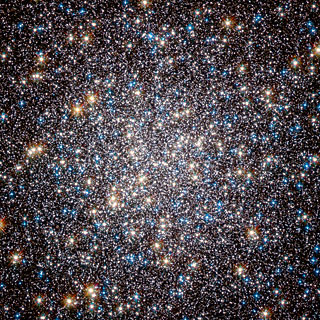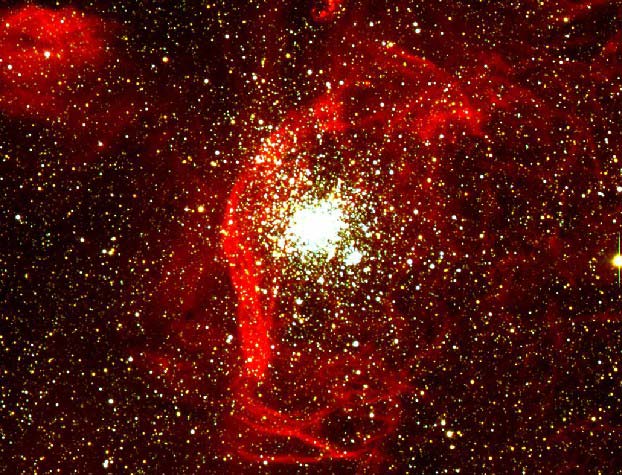I can't resist talking a bit more about the nature of the stars in globular clusters.
Globular clusters are ancient, certainly those we find in the Local Group of galaxies. They are remnants of our galaxies' violent past, when huge gas clouds collided and gave rise to raging star formation and tremendously large and bright clusters. But that happened when the universe was very young, and no true globular clusters have formed in the Local Group for billions of years. Although there is a so called Populous Blue Cluster in the Large Magellanic Cloud:
NGC 1850, a young and extremely rich cluster in the Large Magellanic Cloud. (If you don't think that NGC 1850 looks particularly young and blue, that is partly because the color balance of the image is a bit red. Note, however, the red emission nebulosity around the cluster. This kind of thing is typical of young clusters, and you find nothing like that around any globular cluster in the Milky Way.)
So NGC 1850 is truly remarkably rich for a young cluster. But when today's globular clusters were young, they were much, much richer.
When a cluster is very young, all its stars may be on the main sequence. That means that all stars shine by converting hydrogen into helium in their cores. As long as the stars are on the main sequence the stars are bluer the brighter they are.
This is the young Pleiades cluster. Only the bright blue stars show up in this image. But the Pleiades contains at least three hundred stars, most of which are quite faint and yellowish. If we plot the brightness of the stars of the Pleiades versus the color of the stars of the Pleiades, we get a so called color-magnitude diagram, which in the case of the Pleiades looks like this:
The stars are brighter the higher up in the diagram they are. That is fairly easy to understand. But the stars are also bluer the farther to the left they are in the diagram. You can see that all the bright stars of the Pleiades are far to the left, so they are all blue. All the fainter stars are farther to the right. So the bright stars are blue and the faint stars are yellow, even reddish when it comes to the very faintest stars.
But this is a typical color-magnitude diagram for a young cluster, where all the stars are on the main sequence. As a cluster ages, its brightest, bluest stars exhaust the hydrogen in their cores, and then these stars will change color from blue to red. The most massive stars, which were originally the bluest, will also be the ones which burn out and die first.
Globular clusters are ancient. They don't have any truly massive stars left, no stars like the bright blue stars of the Pleiades. In an ancient globular cluster the brightest stars are the reddest. They are the ones which are about to burn out and die to become white dwarfs surrounded by planetary nebulae. Right before the stars cast off their atmospheres and become white dwarfs they grow monstrously large, with cool, tenuous and reddish atmospheres.
For a low metallicity globular cluster, the color-magnitude diagram looks something like this:
All the stars that are at the very bottom of the diagram are extremely faint, so faint that they don't contribute to the overall color of the cluster at all. The red stars at the bottom are really tiny, lightweight stars on the main sequence, little faint embers that will keep glowing for trillions of years because they burn their meager supplies of hydrogen so incredibly slowly. If these red little mini-stars had been any smaller, they wouldn't have been able to get their hydrogen fusion going at all.
As for the tiny stars to the left, the blue ones, they are hot white dwarfs, scorchingly hot naked cores of stars that have died and cast off all of their atmospheres. The "white" dwarfs are blue because they are so hot, and they are so faint because they are so extremely tiny.
You can see a broad but narrowing "road" of stars that seem to start at the lower right and rise towards the left, while the color of the stars change from red to orange to yellow. The brighter and more "non-red" the stars are, the more massive they are and the brighter they shine. The part of the "road" that "points to the left" is the main sequence. All the stars here shine by converting hydrogen to helium in their cores.
But after a while the broad "road" turns rightwards. The stars are getting brighter, but they are getting ever redder as they are doing so. The point at which the "road" turns to the right is, logically enough, the "turn-off point". This is the point at which the stars have used up the hydrogen in their cores. Remember that the most massive stars use up their hydrogen first, and then gradually the less and less massive stars follow. When the stars reach the turn-off point their central hydrogen is used up, and they have to produce energy by other means. At first their cores contract, which releases heat and makes the stellar atmospheres expand. As the stellar atmospheres expand the stars grow both bigger, brighter and redder. Now the stars have left the main sequence, never to return.
But the stars reach an intermediate stage where they contract again. They have now reached a stage where they produce more energy than they did when they were on the main sequence and burned only hydrogen, so they are brighter than when they were on the main sequence. But they are much smaller than they were when they were truly large. The fact that they have contracted so much, yet produce so much energy, makes them much bluer. You can find these blue stars fairly high up and to the left in the diagram. Note that the very bluest of these stars are fainter than the ones which are not so blue. That is because the bluest stars have become quite small, much smaller than the ones which are not so blue.
The stars in this "blue stage" are called "horizontal branch stars". But it is only in metal-poor clusters that the horizontal branch stars contract and heat up enough to be blue.
Below and to the right of the horizontal branch stars are the blue stragglers. They are the ones which have not "turned right" and left the main sequence when all the other stars of their mass have done so. Astronomers have thought of various reasons for why these stars "straggle" on the main sequence and are brighter and bluer than they "ought to" be. One possibility is that the blue stragglers are the products of stellar mergers in the crowded globular clusters.
But as you can see, the blue stragglers are neither as blue nor as bright as the blue horizontal branch stars.
After a while the stars leave the horizontal branch and begin their final ascent to the right. Now they become huge, bloated, and red. And then they shed their atmospheres, end their fusion processes, and die.
Ann
 The Small Cloud of Magellan
The Small Cloud of Magellan





